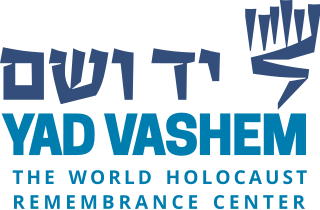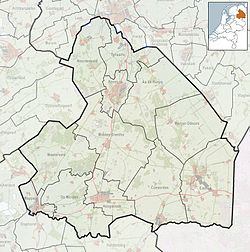
Yad Vashem is Israel's official memorial to the victims of the Holocaust. It is dedicated to preserving the memory of the Jews who were murdered; echoing the stories of the survivors; honoring Jews who fought against their Nazi oppressors and gentiles who selflessly aided Jews in need; and researching the phenomenon of the Holocaust in particular and genocide in general, with the aim of avoiding such events in the future. Yad Vashem's vision, as stated on its website, is: "To lead the documentation, research, education and commemoration of the Holocaust, and to convey the chronicles of this singular Jewish and human event to every person in Israel, to the Jewish people, and to every significant and relevant audience worldwide."

Le Chambon-sur-Lignon is a commune in the Haute-Loire department in south-central France.

During World War II, some individuals and groups helped Jews and others escape the Holocaust conducted by Nazi Germany.

Righteous Among the Nations is an honourific used by the State of Israel to describe all of the non-Jews who, for purely altruistic reasons, risked their lives in order to save Jews from being exterminated by Nazi Germany during the Holocaust. The term originates from the concept of ger toshav, a legal term used to refer to non-Jewish observers of the Seven Laws of Noah.

Emmen is a municipality and town of the province of Drenthe in the northeastern Netherlands.

Oľšavica is a village and obec in Levoča District in the Prešov Region of central-eastern Slovakia.

Jānis Lipke was a Latvian rescuer of Jews in Riga in World War II from the Holocaust in Latvia.

Polish Jews were the primary victims of the Nazi Germany-organized Holocaust in Poland. Throughout the German occupation of Poland, Jews were rescued from the Holocaust by Polish people, at risk to their lives and the lives of their families. According to Yad Vashem, Israel's official memorial to the victims of the Holocaust, Poles were, by nationality, the most numerous persons identified as rescuing Jews during the Holocaust. By January 2022, 7,232 people in Poland have been recognized by the State of Israel as Righteous among the Nations.

Jan and Anna Puchalski were a Polish husband and wife who lived in the village of Łosośna in north-eastern Poland on the outskirts of Grodno during the Nazi German occupation of Poland. Together, they rescued Polish Jews from the Holocaust, including escapees from the ghetto in Grodno before its brutal liquidation. The Puchalskis were posthumously bestowed the titles of Righteous Among the Nations by Yad Vashem in June 1986. Their medals of honor were presented to their surviving children at a ceremony in Jerusalem on June 14, 1987, during which Irena Puchalska-Bagińska, Zdzisław, son of Sabina Puchalska-Kazimierczyk, Władysław Puchalski and Krystyna Puchalska-Maciejewska planted a tree in the Garden of the Righteous at Yad Vashem.

Stanisław Jasiński and his daughter, Emilia Słodkowska née Jasińska, risked their lives and the lives of their families during the Holocaust in order to save Jews from extermination by the Ukrainian Nationalists and the Nazis. They were awarded the medals of Righteous among the Nations bearing their name, a certificate of honor, and the privilege of having their names added to those on the Wall of Honor in the Garden of the Righteous at Yad Vashem in Jerusalem, on February 28, 1985. Stanisław Jasiński received his title posthumously.
Yad Vashem, the state of Israel's official Holocaust memorial, has generally been critical of Pope Pius XII, the pope during The Holocaust. For decades, Pius XII has been nominated unsuccessfully for recognition as Righteous Among the Nations, an honor Yad Vashem confers on non-Jews who saved Jewish lives during the Holocaust altruistically and at risk to their own lives.

Gisela Legath from Eberau was a Burgenland woman who saved with the help of her two children Martin Legath and Frieda Legath the life of two Hungarian Jews from the Nazis during World War II by providing a shelter in their barn.

The Garden of the Righteous Among the Nations is part of the much larger Yad Vashem complex located on the Mount of Remembrance in Jerusalem. Along with some two dozen different structures within the Yad Vashem memorial – which is the second most-visited destination in the country after the Western Wall – the Garden of the Righteous is meant to honor those non-Jews who during the Holocaust risked their lives to save Jews from extermination by the Nazis.
Hendrika Jacoba "Kiky" Gerritsen-Heinsius was recognized by Yad Vashem as Righteous Among the Nations on 15 September 1989, and was also awarded the Verzetsherdenkingskruis by the Dutch government.

Willemiena Bouwman, also known by her resistance alias, Mien van Trouw, was a social worker and member of the Dutch Resistance who rescued dozens of Jewish children who were at risk of persecution and deportation by Nazi officials during World War II. She also played a role in the development of the Dutch newspaper, Trouw, as one of its earliest employees.

Gerritdina Benders-Letteboer (1909–1980) was a member of the Dutch Resistance, who actively protected multiple Dutch Jewish citizens from Nazi persecution and deportation during World War II. Posthumously declared with her husband, Johan Benders (1907–1943), to be Righteous Among the Nations on 27 March 1997 by Yad Vashem, she and her husband were also honored by The International Raoul Wallenberg Foundation, which placed their names on their “List of Dutch Saviors.”

Elisabeta Strul was a Romanian woman who saved Jews during the Holocaust and was recognized as a Righteous Among the Nations by Yad Vashem for her actions during World War II. She married Marcus Strul, a Jew who worked with her in the textile factory where she worked. They immigrated to Israel and started a family.












